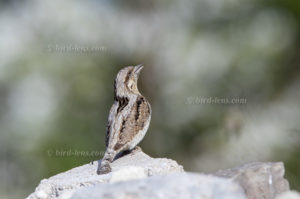 An Eurasian Wryneck (Jynx torquilla) sitting open on a stone singing in the morning light is a really rare sighting. The obtrusive väh-wäh-wäh – calls can be heard from afar. The emitting bird remains hidden. In the second half of April, the powerful courtship calls of a bird, which is rarely seen, are often heard. The Eurasian Wryneck is to be heard. Its voice is unmistakable. The Eurasian Wryneck prefers open landscape forms as a habitat. So its breeding ground in Europe can be found in orchards, parks and open, light forests. The Eurasian Wryneck spends the wintering season in Africa. At the end of March / beginning of April it returns to its breeding area. The Eurasian Wryneck quickly discovers a new breeding cave. The Eurasian Wryneck is grey-brown above, finely striped like a bark, below creamy yellow and has at the throat a grey-brown banded plumage. The Wryneck almost looks like a long-drawn sparrow. But the Wryneck can turn its head 90 degrees. This ability helped him to his name. Due to its camouflage color, it is particularly difficult to find it. But if it is in court in the spring, he mutates to the real screamer. Then the nasal calls of both sexes are hard to miss. During this time, the best options are to photograph different behaviors of this bird.
An Eurasian Wryneck (Jynx torquilla) sitting open on a stone singing in the morning light is a really rare sighting. The obtrusive väh-wäh-wäh – calls can be heard from afar. The emitting bird remains hidden. In the second half of April, the powerful courtship calls of a bird, which is rarely seen, are often heard. The Eurasian Wryneck is to be heard. Its voice is unmistakable. The Eurasian Wryneck prefers open landscape forms as a habitat. So its breeding ground in Europe can be found in orchards, parks and open, light forests. The Eurasian Wryneck spends the wintering season in Africa. At the end of March / beginning of April it returns to its breeding area. The Eurasian Wryneck quickly discovers a new breeding cave. The Eurasian Wryneck is grey-brown above, finely striped like a bark, below creamy yellow and has at the throat a grey-brown banded plumage. The Wryneck almost looks like a long-drawn sparrow. But the Wryneck can turn its head 90 degrees. This ability helped him to his name. Due to its camouflage color, it is particularly difficult to find it. But if it is in court in the spring, he mutates to the real screamer. Then the nasal calls of both sexes are hard to miss. During this time, the best options are to photograph different behaviors of this bird.
Since the Wryneck cannot make its own breeding caves, it is dependent on natural excavations in trees or on the caves of woodpeckers. Even artificial nest boxes are accepted if the habitat fits.
Due to the decline in agriculture and the lack of orchards as food for the wryneck, the populations of Eurasian Wrynecks turned down dramatically. The today’s fruit plantations are occupied almost exclusively with half-stemmed, picking-ripe fruit trees. The problem is that the pests in the plantations are usually sprayed away with poison. The chemical mace is still used in fruit monocultures. Therefore, the huge orchard plantations are not suitable habitats for the Wryneck. Just a few decades ago, the proportion of people working in agriculture was much higher. Each yard also had an orchard. On these meadows mostly high-stemmed fruit trees were planted. The variety of the fruit was much higher. The orchards were well maintained. The fruit trees were pruned to carry as much and long fruit as possible. The orchard itself was mown with the scythe. The floor was thus, in contrast to the mowers today, not compacted. This also benefited the ants.
The two sexes come together only for breeding and then fly separate ways again. If the Eurasian Wrynecks starts in May with its usually single brood in the year, many caves are already occupied. But that hardly bothers the Eurasian Wryneck. It makes in this case short process and throws disturbing birds out of the nests. Even with nest construction the bird does not stay up late. The females simply lay the seven to ten white eggs on the bare floor of the cave, on multh or on nesting material already found.
If a breeding Wryneck is threatened and cornered, the bird shows the maneuver that earned it its name: he bows the plumage, spreads his tail and lets his wings hang. In this attitude he jumps at the enemy, turns horrible with eyes and neck, lashes with his long worm-tongue, gurgles from deep throat, bangs and hisses. In view of such a spectacle, many predators are at least temporarily distracted. In many cases they pause in the attack. Maybe long enough until the talented actor manages to escape. If the young are a bit older, they sound a strange noise and trills from morning till night. But if they feel threatened, they already show the typical wry-haired spectacle of their parents and hiss and hiss.
The Wryneck feeds mainly on meadow ants, which create their nests in sunny-warm and especially sandy soils. Extensive farming, sealing and “tidying up” of nature reduces the food supply for the Wryneck. And if there is not enough food, the bird does not get its young fledged.
To cope with the growing demand for top shots of the rarer species of the Palearctic Bird-Lens is keen to enrich the range of pictures of birds you can find in the western palearctic. Trips to remote places like this one to capture images not only of rare birds of western palearctic were very successful. The nice image of the blog is only a first impression, what you will find in the gallery in the “Picture Shop” very soon. Just give me a message, if I could serve you with an image needed before the new pictures are online.